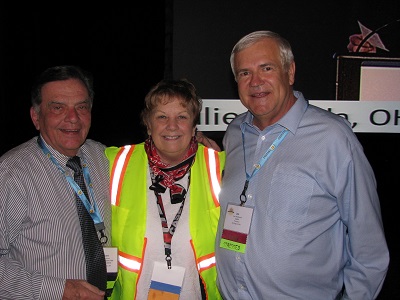Live Auction Report 2016
The NACD Live Auction 2016 is in the books! Several hundred attendees enjoyed the announcing of Lane Nordlund, the calling of Johnny Regula, and the efforts of staff, committee members and bid spotters to make this year's auction the most successful ever. Lane Nordlund, the calling of Johnny Regula, and the efforts of staff, committee members and bid spotters to make this year's auction the most successful ever.
The highlight of the evening was the bidding for Case IH tractors! Case IH provided 2 tractors for the event--each with 100 hours use for the winning bidder and 100 hours for their local district. In addition, Case IH representative Patty Lardie gave the use of one additional tractor to the second highest bidder! The combined total for just these three items netted $30,000 to support NACD education and outreach!
NACD thanks the following for their contributions:
Our Sponsors - Case IH, John Deere, LG Seeds, Bayer, Monsanto, Verdesian, Green Cover Seed, Bane-Welker Equipment, Henry Rifle, Grand Sierra Resort, and Sheraton Denver.
Individuals- Cindy and Ian Cunningham, Bob Warner, John and Ginger McDonald, Michelle Hoffman.
Associations- Texas, Kentucky, Missouri, Alabama, Illinois BOD, Ohio, Tennessee, South Dakota, Ohio, Rhode Island, Kansas, Arizona, North Dakota, Louisiana, Wyoming, Mississippi, Pennsylvania, Oklahoma, Oregon, Vermont, New Mexico, Colorado, Idaho, Arkansas, West Virginia, Utah, Iowa, Georgia.
SWCDs- Prince Georges, Trumbull, Brown, Upper Washita.
The NACD Executive Board and of course Beth Mason for her beautiful conservation-inspired quilt!
Please make a point of thanking your local dealers, suppliers, and everyone involved for their support of NACD. Finally, a special thanks to all the bidders and Draw Down participants without whom none of this would be possible!
Thanks again, all!
Tim Palmer- Auction Chair, NACD Executive Board Member from Iowa
Pictured: Cal Steuart, NACD Board Member from Maryland, Patty Lardie from Case IH, and NACD President Lee McDaniel
RCPP: USDA selects 84 projects for FY16 RCPP
The U.S. Department of Agriculture (USDA) and its partners will direct up to $720 million towards 84 conservation projects through the Regional Conservation Partnership Program (RCPP). The funding will help communities improve water quality, combat drought, enhance soil health, support wildlife habitat and protect agricultural viability. The 84 selected projects will also include proposed partner matches totaling $500 million.
Click here for a full list of 2016 projects.
Fighting Invasives in Michigan
The Manistee and the Grand Traverse conservation districts in northwestern Michigan both received funding from the Michigan Invasive Species Grant Program to fight invasive species in their regions.
The Manistee Conservation District received $115,025 to fight the spread of oak wilt affecting area oak trees. Oak wilt is a fungus that spreads rapidly through the root system or spores of oak trees and is especially deadly for red oaks. Cases of oak wilt have been identified further west than previously observed spurring the need for increased efforts to arrest its growth. The funds from this grant will help landowners pay for preventive and corrective measures to stop the spread of the fungus.
The Grand Traverse Conservation District received a $156,400 grant to build upon their invasive species prevention programs. Funding will go toward fighting Japanese Knotweed, phragmites, and baby’s breath, which crowds out native plants such as the threatened pitcher’s thistle.
Coastal Wetland Funding
Earlier this month, the U.S. Fish and Wildlife Service (FWS) Director Dan Ashe announced that more than $20 million will be provided to 28 projects in 12 coastal states in order to protect, restore or enhance more than 10,000 acres of coastal wetlands and adjacent upland habitats under the National Coastal Wetlands Conservation Grant Program. The FWS’s funding is being matched by state and local governments, private landowners, conservation groups and other partners.
States receiving the funds are California, Georgia, Maine, Maryland, Michigan, New Hampshire, New Jersey, North Carolina, Oregon, South Carolina, Virginia and Washington. Click here for the complete list of projects funded by the 2016 grant program.
Ruling on Northern Long-Eared Bat
Last month, the U.S. Fish and Wildlife Service (FWS) published a revised final rule regarding the Northern Long-Eared Bat. In April of last year, the FWS listed the Northern Long-Eared Bat as a threatened species and issued an interim rule specifying what constitutes a prohibited take and the exceptions to those prohibitions. The final rule removes prohibitions that would otherwise be in place on “incidental take” of the bat in areas not affected by white-nose syndrome. Incidental take includes harm, harassment or mortality that occurs incidental to an otherwise lawful activity, such as clearing trees for a construction project.
In areas impacted by white-nose syndrome, incidental take is prohibited if it occurs within a hibernation site for the Northern Long-Eared Bat. It is also prohibited if it results from tree removal activities within a quarter-mile of a hibernaculum or from activities that cut down or destroy known occupied maternity roost trees, or any other trees within 150 feet of that maternity roost tree, during the pup-rearing season (June 1 through July 31).
Click here for the FWS’s press release for further information.
|
|
|
|
|
Email Marketing By
|


|
|
|
|
|